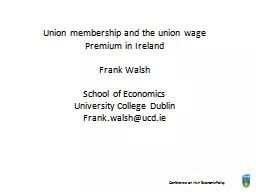

Frank Walsh School of Economics University College Dublin Frankwalshucdie Are Trade Unions good or bad for employment and efficiency Theory suggests it depends on The objective of unions ID: 586884
Download Presentation The PPT/PDF document "Union membership and the union wage Prem..." is the property of its rightful owner. Permission is granted to download and print the materials on this web site for personal, non-commercial use only, and to display it on your personal computer provided you do not modify the materials and that you retain all copyright notices contained in the materials. By downloading content from our website, you accept the terms of this agreement.
Slide1
Union membership and the union wage Premium in Ireland
Frank Walsh
School of Economics
University College Dublin
Frank.walsh@ucd.ieSlide2
Are Trade Unions good or bad for employment and efficiency
Theory suggests it depends on:The objective of unionsThe level and degree of co-ordination in bargainingThe legal/institutional framework and how competitive labour and product markets are
Empirical literature
Impact of unions on firm performance and productivity is mixed
Across countries evidence that unions increase unemployment unless there is co-ordination across firms and sectorsSlide3
Arguably if
unions are un-representative or if membership is unbalanced co-ordination across sectors is more difficultWalsh 2009 looked at trends in Trade Union membership 2001 2006
No matter how you looked at the data there seemed to be a decline in the percentage of employees who were members
Changes in composition of job and worker type could not explain this decline
The exception is Public Administration
This is consistent with international evidence of decline in membership across a wide range of countries (concentrated in the private sector) Slide4
Quarterly National Household Survey quarter two
2003/11
This does not include
N
on-employed members
N
on-members covered by union contracts but not membersOther agreements: ( JLC’s, REA’s)
Density recovers during recession as a share of employees but continues to decline as a share of labour force
Indicates
decline
in
union number of employees less
than in non-unionSlide5
Quarterly National Household Survey quarter two
2003/11Boom and bust cycle much greater for total number employees than for union employment Slide6
International literature shows a decline in membership across most
countries over timeVery of often the decline greater for private sector workersThis trend is pronounced in the Irish case
Percentage members in Public vs. Private sector Slide7
Proxy for Public Sector is
Public Administration, Education and Defence. Private sector is all other employees
Quarterly National Household Survey quarter two 2003/10
Steady decline in private sector density continues throughout
The density is fairly stable for public sector employees Slide8
Is the pattern in membership reflecting a change in the composition of the workforce/jobs or is there an underlying trend?
We can look at the probability that an employee is a union member in each year and control for worker and job characteristicsControls are for: age, gender, education, nationality, region, urban status, industry, occupation and firm size
Create an index starting at 100 and compare the raw density with the change in probability of membership when control for worker and job characteristics
Changes in the composition of jobs/workersSlide9
Quarterly National Household Survey quarter two 2003/10
When we control for changes in composition there is a steady decline in union density over the periodSlide10
Measuring the union wage premium
Can unionised firms choose more able workers for higher paying union jobs? This would imply the observed wage premium overstates the true premiumBut unionised firms have compressed wage structures and lower returns to skillHighest skill workers might do better in non-union jobs
Empirical literature suggests that there is two sided selection
Union firms can
choose at lower skill levels
to ensure they don’t get the least able workers but will not attract the most able
Empirical evidence internationally supports this two sided selection and suggests ability bias will cancel out on average?Slide11
What if follow the same workers over time and observe those who switch union status. Does their wage rise or fall? Ability is fixed
A problem with this is that a small % of workers randomly miscode in all surveys. These will almost always look like they change union status from one period to the nextA high percentage of the fraction of the sample who appear to be moving may be just miscodes
The union premium will be biased downwards since wages will not change for the workers with miscodes
SILC data for Ireland asks workers if paid a union sub on last wage packet. Separate question asks how much it is. For over 60% of sample the payslip is observed
Arguably for this sub-sample measurement error in the union variable will be very low. You would have to incorrectly report paying a sub or not, then report an incorrect amount that is consistent with this and the interviewer would observe your payslip and fail to resolve this inconsistency Slide12Slide13
Wage premium declining over time for all specificationsSlide14
Discussion/Conclusion
Union density on a downward trend especially in private sectorUnion wage premium at around 8-10% from 2006-10 but seems to have fallen substantially during recent recession
A
labour market with co-ordinated
sectoral
bargaining does not seem feasible without representative employer groupsA key difference between countries with low and high rates of representation is the degree to which worker representative bodies are involved in the provision of other services (pensions/social security)Slide15